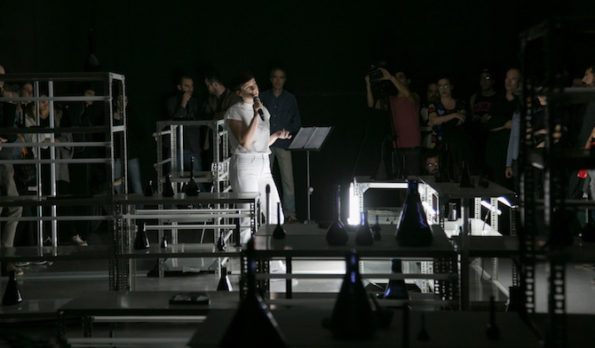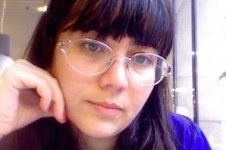Search
To search for an exact match, type the word or phrase you want in quotation marks.
A*DESK has been offering since 2002 contents about criticism and contemporary art. A*DESK has become consolidated thanks to all those who have believed in the project, all those who have followed us, debating, participating and collaborating. Many people have collaborated with A*DESK, and continue to do so. Their efforts, knowledge and belief in the project are what make it grow internationally. At A*DESK we have also generated work for over one hundred professionals in culture, from small collaborations with reviews and classes, to more prolonged and intense collaborations.
At A*DESK we believe in the need for free and universal access to culture and knowledge. We want to carry on being independent, remaining open to more ideas and opinions. If you believe in A*DESK, we need your backing to be able to continue. You can now participate in the project by supporting it. You can choose how much you want to contribute to the project.
You can decide how much you want to bring to the project.

Close to the conclusion of her celebrated Manifesto for Cyborgs (1985) Donna Haraway thanked a group of science fiction writers such as Joanna Russ, Samuel R. Delany, James Triptee Jr. and Octavia Butler for their involuntary contribution to this new myth about identity and contemporary political imaginaries. If we add to these references the weightless delicacy of the speculative anthropologist Úrsula K. Le Guin –omnipresent in the work of Miguel, we could consider Haraway’s theses as one of the principal sources from which Aura Nera drinks in its immersion into the contemporary conditions for the production of knowledge as technologies of fiction and hypothetical devices. Like the works of speculative fiction of those authors, Aura Nera becomes an artificial oracle where the possibility of a post-humanist utopia arises from a simultaneous and contradictory act: the rescue of the mythological past and a headlong dash forwards, a prospection of our future as biological entities survivors of what we currently know as “life”.
The laboratory: a scenario for uncertainty.
“Believe me, this darkness is a place into which you can enter and be out of danger like any other”. This suggestive phrase greets us, inscribed in a white font on a magnanimous black curtain and functions as a portal between worlds. The characteristic hubbub of Las Ramblas in December is left outside, inside the side room of the Arts Santa Monica centre we enter into a peaceful but unpredictable space-time. Because this welcoming sentence functions as a Carrollian invitation, like the disturbing “Drink me” of the bottle of Alice, inaugurating an installation, a labyrinth of metallic structures, industrial shelves bearing fluorescent tubes that dazzle with flickering strobe lights that replicate the cycle of day and night. Simulacra of artificial conditions to create biological entities, manipulated to the extreme to trigger a demythologising of their customary use.
That is how Aura Nera recreates the self-sufficient semiosphere of science, a cultural “stratum” condensed with symbols and meanings that have an archetypal scenario: the laboratory. Nevertheless, in this case, it functions as a laboratory of artificial cultures, free of biological manifestations sensitive to human control. A fictional scenario that becomes a bank of samples, a collection of geological, herbal prototypes or immaculate rooms of natural history museums, and other controlled environments that the artist, Regina de Miguel, visited in contexts like the Centro de Astrobiología associated with NASA in Madrid, the laboratories for in vitro cultures of endangered species of the Botanical Gardens in Sao Paulo, the Vulcanology Institute at the Universidad de Barcelona, the Natural Sciences Museum in Santiago de Chile and the Seed Bank of the city of Vicuña, also in Chile.
Unlike the proliferation of glass test tubes, containers or instruments typically of a transparent material, that makes it possible to view at a glance its content, a selection of opaque, black laboratory receptacles are exhibited in this laboratory.
The black mirror: an epistemological threshold.
Alongside these containers are exhibited a series of black crystals. They are samples of obsidian, a geological material carrier of a suggestive polysemy. Since Antiquity, obsidian has been attributed the character of a portal between universes, a connecting object, a magic surface, esoteric interface, similar to the smooth screens of new technological devices of contemporary communication. As the material per se of black mirrors, magical contraptions, obsidian serves as a window to ambivalent fantasies: condensing the potential of the self-reflecting gaze with outward prospection, divination and oracular power. This omnipresent darkness in the objects exhibited in Aura Nera also speaks to us of the limits of human knowledge exposed as a paradigm for contemporary astrophysics. The state of current research in dark matter and energies, as well as black holes, evidences that our knowledge of the cosmos is very limited (as the theoretical physicist and divulgator of science Carlo Rovelli (2016) upholds “science teaches us to know the world but also to understand the immense vastness of which we are still ignorant”) and thus requires new speculative orders. Between a laboratory and museum of natural history, the dark laboratory materials, the black glassware as much as the samples of obsidian, question the logic and usually functional or utilitarian meanings and call upon us to make new associations and produce new meanings.
From the laboratory to the labyrinth: a dark biosphere.
“They say that in an era of myths, undifferentiated from fantasy and without any distinction between females or males, human beings or beasts there was a final moment, the moment of the crime” This phrase inaugurates the sound piece that lends meaning to this laboratory-museum room of ghostly sciences. The spectral voices of the artist Lucrecia Dalt and the choreographer and performer Ania Nowak, akin to a sinister Greek chorus, configure the narrative framework complementing this allegorical darkness omnipresent in the objects of the installation. The recreation of the stories of Medusa, Hecate, Medea, Persephone and the Harpies, the references to the supernatural mythological triads like the Hesperides, the Moirai or the Gorgons reversion the founding myths. And their efficiency guarantees a continual intersection, with sentences about the hypotheses of contemporary theories of simulation, liminality or microbiology. This is how a soundscape is created that evokes dreams and remote experiences and the founding myths are brought up to date as possibilities in a post-human future, auguring new forms of life in a “dark biosphere”.
Aura Nera owes its name to a scene from Dante’s Infierno where an invisible, dark wind threatens to intervene in the physical world without materialising as anything solid. The scene includes the legendary king Minos, son of Zeus and Europa, who was the creator of the labyrinth, the symbol for the lack of certainties, for doubt. Hence how in this scenario the laboratory becomes a labyrinth, and we are guided by a “dialectic of the monstrous”. This promotes unease and astonishment in the face of the unknown and speculates with the modern forms of power and (un)awareness of the biochemical, the microbiological or theoretical physics to “illuminate” the possibility of a dark biosphere where the shadow of the post-human takes shelter in the utopia.
Black air and Chtuluceno: the post-humanist utopia
Aura Nera brings the cycle, Xarxa Zande, curated by Oriol Fontdevila, to an end. Its name recoups the “Zande net” a hunting tool, a trap of a Sudanese tribe that by being exhibited in an artistic context annihilated the limits between art and artefact. It became in this way the object of a heated debate about the artistic institution itself that involved impassioned interventions by recognised anthropologists, historians and art critics. In this evident curatorial desire to appeal to the artistic artefact, Aura Nera becomes a transformation of those used in the first exhibition of the cycle, Unblackbox by Black Tulip that included some metallic shelves, reused as the scenario for this obscurantist laboratory-labyrinth. Moreover, Aura Nera picks up on two previous proposals Ansible (exhibited in the gallery Maisterravalbuena in Madrid in April 2015 and that included this type of metallic shelving) as well as We Are a Plot Device also in collaboration with Lucrecia Dalt (Capella de Sant Roc, Valls, 2016) and amplifies them, effecting an archaeology of the ideas that expand, configuring the conditions for the possibility of other works. Like the text that presents Aura Nera: the summary of the apocryphal novel, a Borgian excursus at the hand of Víctor García Tur or the role play, a global conspiratorial paranoia “space opera” invented by the writer himself. Thanks to these rhizomatic projects, that expand in an unpredictable manner, stemming from the contexts that propitiate and foment them, art becomes the fictional technology while at the same time practices speculative anthropology.
If an ansible, in its original meaning, is “a hypothetical device for communication faster than light” (a concept created by Ursula K. Le Guin in 1966 for Rocannon’s World) we could state that the prospection towards the future incubated in Aura Nera, converts the artistic experience, in its confluence with such ontological and epistemological suspicions, into a hypothetical device. A futurist oracle where the desire for knowledge and its consequent epistemological frustration is disarticulated through an archaeology into its own mythopoetical capacity (in the past, myths; in the present, science) as discourse. This is how in this work the laboratory becomes a labyrinth of meanings, where installation, performance and sound landscapes converge with natural history, scientific knowledge and classical mythology appealing to these fragile certainties underpinned by the myth of separation between nature and culture. In this way Aura Nera, in its illuminating obscurantism, allows a glimpse of the tentacles of this Chtuluceno predicted by Donna Haraway (2016), where the fusion of the animal with the mechanical augurs a post-humanist utopia in this puff of “black air”, that, without acquiring physical form, is made manifest in the hypothetical future forms of life and hope.

Ana is fascinated to dive into books and movies, to approach with caution those tentacles that lie in the depths and to return to count what she has seen. She has published “Este es el momento exacto en que el tiempo empieza a correr” (Premio Antonio Colinas de Poesía Joven), the novels “La puerta del cielo” and “Hemoderivadas”, “Constelaciones familiares” (short stories, Premio Celsius Semana Negra de Gijón) and “Érase otra vez. Contemporary fairy tales” (essays). She currently lives and works between Berlin and El Paso, Texas, where she is a Bilingual MFA Fellow in Creative Writing at UTEP. Some of her texts have been translated into Portuguese, Italian, Polish, Lithuanian, German and English.
"A desk is a dangerous place from which to watch the world" (John Le Carré)